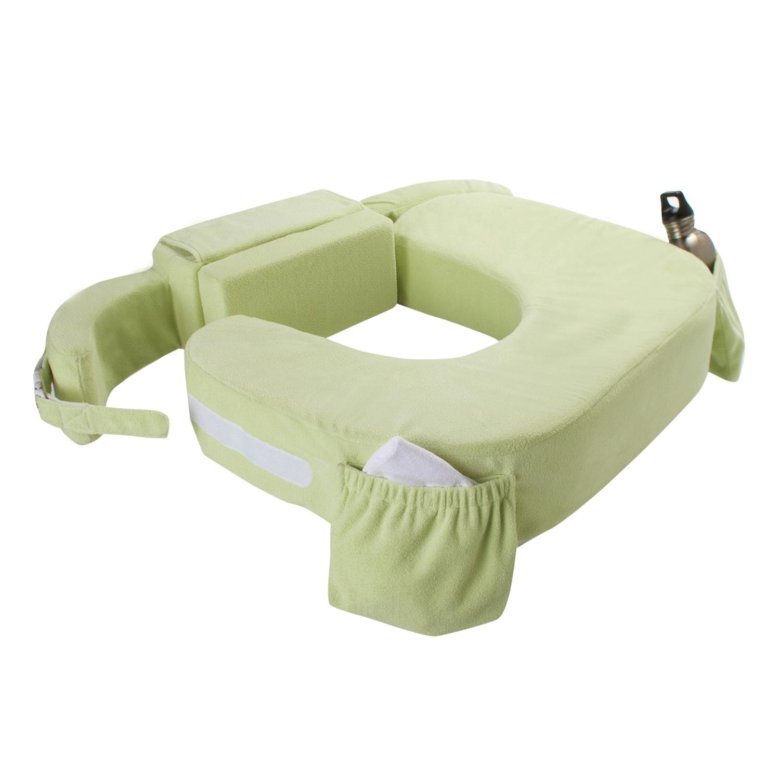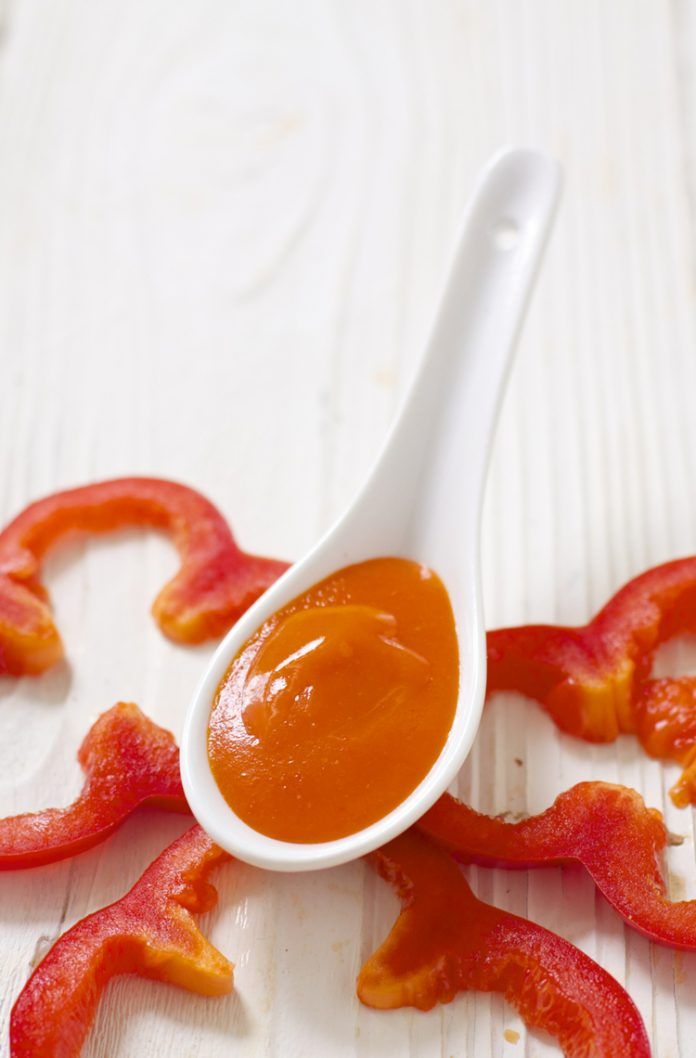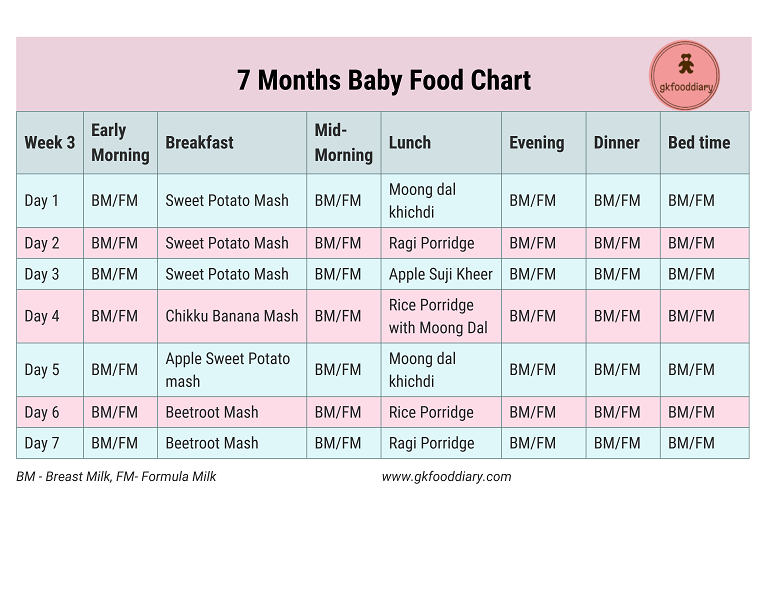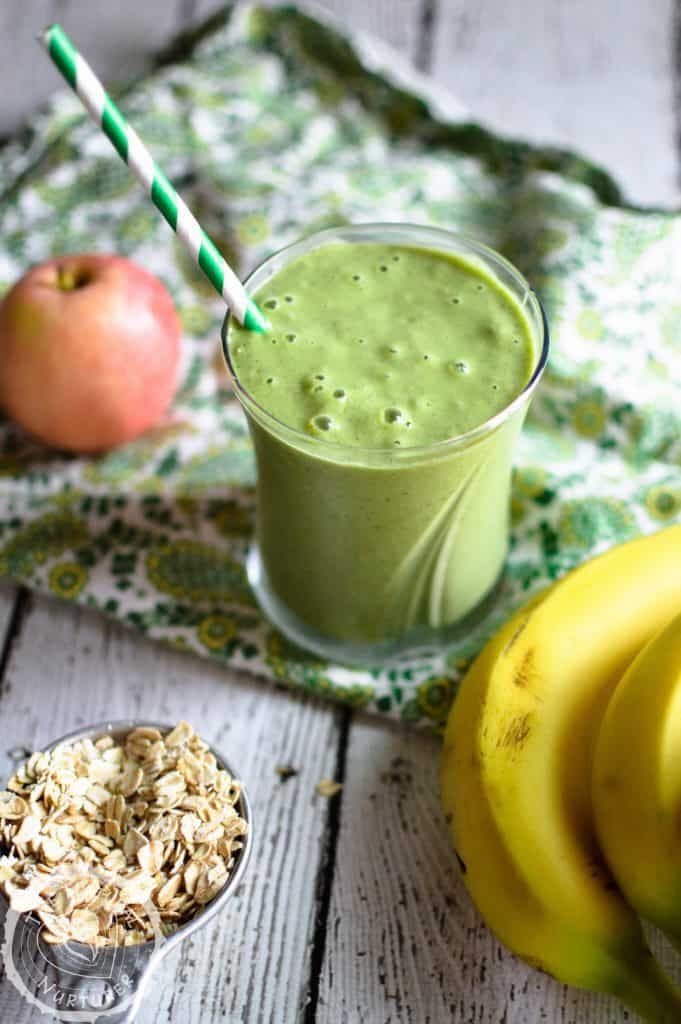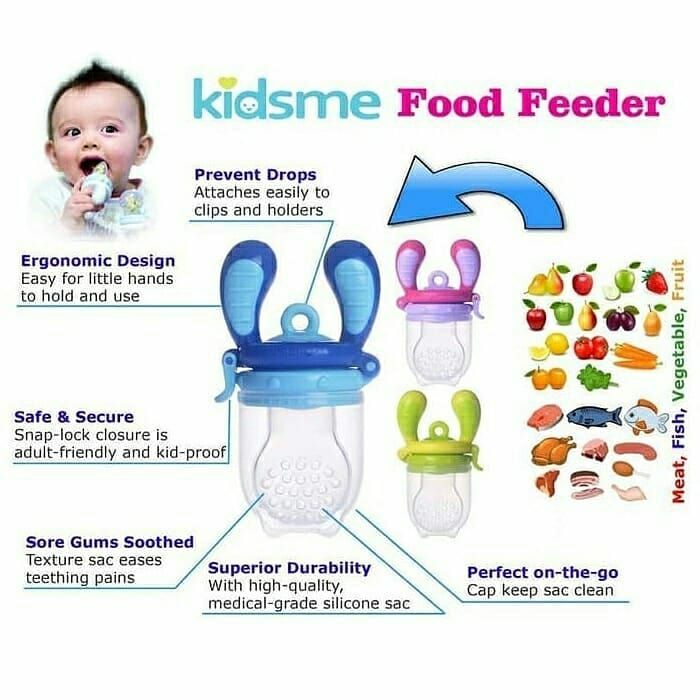Nine month baby food
Foods, Tips, and Meal Plan for Feeding Your 9-Month-Old
By the time your baby is 9 months old, they have likely been eating solid foods in addition to either breast milk or formula for a few months.
It can be overwhelming deciding what foods to feed your little one, especially when you’re most likely already busy babyproofing and soaking up all the new and exciting milestones.
This article provides an overview of some of the best foods for your 9-month-old, as well as which foods are best avoided so that you can help your baby get all the nutrients they need.
Even though your 9-month-old is eating food, their main source of nutrition should continue to come from either breast milk or formula. Any additional foods can be considered complementary until your baby turns 1 (1, 2).
Some parents choose to begin with puréed foods when first starting solids, while others may opt for a baby-led weaning approach, which involves offering foods in their solid form with an emphasis on allowing babies to feed themselves (3).
If your baby eats purées, the American Academy of Pediatrics (AAP) recommends beginning to offer foods with varying textures and some more solid foods that help a baby learn how to chew around 8 months of age (2).
Some great foods to offer your 9-month-old baby include:
- Fruits: bananas, soft pears, peaches, watermelon, cantaloupe, strawberries
- Vegetables: soft-cooked broccoli, carrots, green beans, sweet potatoes
- Protein: eggs, soft-cooked or ground meat, tofu, smashed beans, low mercury fish
- Healthy fats: avocado, fish, olive oil, nut butters
- Iron-containing foods: eggs, meats, fish, iron-fortified cereals, whole grain bread or pasta
Key nutrients for baby
Offering a variety of foods will provide your baby with a variety of important nutrients, some of which are especially important for healthy growth and development.
Vitamin D plays an important role in bone health and may help build strong immune systems in babies, though more research is needed on the latter.
Infant formulas are typically fortified with vitamin D, but it’s often recommended that breastfed babies take a supplement of 400 IU of vitamin D per day for their first year of life (4, 5).
Because babies experience such rapid growth in the first year, they’re at a high risk of an iron deficiency, which can lead to serious health outcomes.
Iron supplementation may be needed after the first 6 months, but it may not be necessary if your baby is getting enough iron-rich food sources regularly or drinking formula, which is typically fortified with iron (5, 6).
Healthy fats, particularly omega-3 fatty acids, are also important for babies and young children. They help promote the development and function of brain, eye, and immune health (7, 8, 9).
SummaryOffering your baby a variety of foods will provide them with a variety of important nutrients, but keep in mind, their main source of nutrition should still be breast milk or formula at this age.

While most foods are OK for babies as long as they are prepared and cut appropriately, some foods should be avoided in the first year. Some foods may cause food poisoning in little ones, and others are considered choking hazards.
Here are some important foods to avoid feeding your 9-month-old (10):
- honey
- raw or undercooked meat, fish, or eggs
- fish containing high amounts of mercury, such as shark, swordfish, and marlin
- added sugars
- salt and high sodium foods
- unpasteurized foods
- potential choking hazards like whole grapes, whole nuts, raw fruits and veggies
You may have heard that babies under 1 year shouldn’t drink cow’s milk. That’s because they should still be drinking formula or breast milk to meet their nutritional needs.
They can have milk mixed into foods, such as oatmeal or smoothies, but you could also use breastmilk or formula.
Babies shouldn’t get added sugar, which can replace more nutritious options. Also, too much sodium may be harmful to their developing kidneys, so it’s best to limit their salt intake (10).
Also, too much sodium may be harmful to their developing kidneys, so it’s best to limit their salt intake (10).
SummaryIt’s important to stay away from certain foods in the first year of life because they can cause food poisoning or choking or may not be the best choices for their developing bodies.
A 9-month-old needs 750–900 calories per day and about 400–500 should continue to come from breast milk or formula (2).
You don’t need to track your baby’s calorie intake, but you may wonder how much to offer at each meal and snack.
Babies will eat when they’re hungry and stop when they are full, so you can let them decide how much they would like to eat.
Your baby will likely show cues of feeling full, such as turning his or her head away from you or pushing food away, and also show signs that they’re hungry, such as opening their mouth for food or getting excited (11).
SummaryA 9-month-old baby needs about 750–900 calories per day.
Be sure to keep up with regular formula or breast milk feedings to help them meet their needs, and let your baby decide when they’re full at meals.
It’s normal for your little one’s appetite to vary day to day. Remember, breast milk or formula should continue to be the main source of nutrition for the first year of life, and babies should be getting about 24 ounces (720 mL) of either daily (2, 12).
You can and should also offer water with meals at this age to encourage proper hydration and help wash down solid foods. At this age, it’s recommended babies get about 4–8 ounces (0.5–1 cup) of water per day (13).
As for other beverages, the AAP recommends sticking to just water and breast milk or formula at this age and avoiding sugar-sweetened beverages and other drinks until 2 years of age. Cow’s milk or soy milk can be introduced after 12 months (13).
Here’s a sample menu for a 9-month-old, including 3 meals, snacks, and breast milk or formula:
Breast milk or formula
6 ounces (177.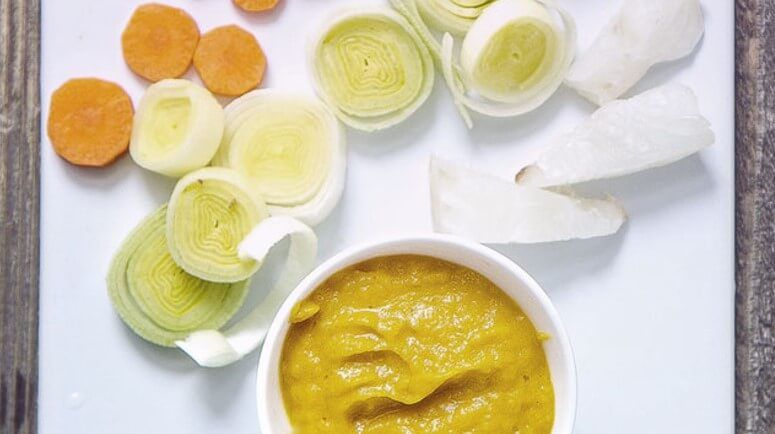 4 mL)
4 mL)
Breakfast
- 2–4 ounces (59.1–118.3 mL) of prepared iron-fortified cereal
- a banana or other fruit (you can try cutting it up or mashing and mixing it into the cereal, too)
- about 1 teaspoon of nut butter stirred into the cereal
Snack (optional)
One of the following options:
- soft (or cooked) fruit
- plain, whole milk yogurt
- teething biscuits
Breast milk or formula
6 ounces (177.4 mL)
Lunch
- scrambled egg
- soft-cooked broccoli
- whole wheat toast with mashed avocado (try cutting it into strips for easy self-feeding)
Snack (optional)
One of the following options:
- cubed cheese
- whole milk cottage cheese
- soft (or cooked) fruit
Breast milk or formula
6 ounces (177.4 mL)
Dinner
- soft-cooked shredded chicken (the slow cooker is great for this)
- smashed peas
- roasted sweet potato wedges
- soft (or cooked) fruit
Breast milk or formula
6 ounces (177. 4 mL)
4 mL)
SummaryAbove is a sample menu for a 9-month-old baby. Remember, babies will let you know when they are full, and they may not eat everything offered. It’s important to continue to offer at least 24 ounces (720 mL) of breast milk or formula daily.
Feeding your little one can feel daunting, but there are ways to keep it simple so you don’t have to spend too much time cooking and prepping.
Here are some quick meal and snack ideas for your 9-month-old:
Quick and easy breakfast ideas
- scrambled eggs, or a veggie omelet with soft fruit, and whole wheat toast topped with smashed avocado
- French toast made with 1 egg and a sprinkle of cinnamon, topped with plain whole milk yogurt and no-sugar-added applesauce
- plain, whole milk yogurt or whole milk cottage cheese mixed with soft fruit and Cheerios
- iron-fortified cereals mixed with nut butter and smashed fruit
Quick and easy lunch or dinner ideas
- baby meatballs with mashed potatoes and soft-cooked green beans
- Combine 1 pound (0.
 45 kg) of ground meat with 1 egg and 1/2 cup oat flour (plus any seasoning you’d like, other than salt).
45 kg) of ground meat with 1 egg and 1/2 cup oat flour (plus any seasoning you’d like, other than salt). - Roll the mixture into meatballs and bake or cook them with a little chicken broth in an instant pot or slow cooker.
- Combine 1 pound (0.
- shredded chicken with smashed peas and corn
- whole wheat penne pasta with low sodium marinara sauce
- poached fish with sweet potato wedges and soft-cooked broccoli and carrots
- diced tofu with soft-cooked green beans and smashed chickpeas
Quick and easy snack ideas
- soft-cooked vegetable finger food, such as asparagus, cauliflower, broccoli, carrots, or potatoes
- toast or crackers with smashed avocado
- soft or cooked fruits like banana, ripe peaches, strawberries, or cooked pears
- cubed cheese
- plain whole milk yogurt
- whole milk cottage cheese
- hard-boiled eggs
SummaryFeeding your 9-month-old can be overwhelming and time-consuming.
It’s a good idea to have some go-to ideas in your back pocket for quick and easy meals.
Meal prep
Meal prepping is a great way to save time and set yourself up for an easier week. If you can, try planning some meals ahead of time and doing some cooking in advance so that you can reheat things during the week rather than cooking daily.
By the time your little one is 9 months old, they can eat a lot of what you’re eating. When you prepare a meal for yourself or the rest of the family, see what you can do to make it baby-friendly. Here are some tips:
- Leave the salt out until you portion out your little one’s helping first.
- Cut foods into safe sizes for your baby to consume.
- If you’re using a spicy or high sodium condiment, set aside some food for your baby before adding it in.
- Check the texture of the meal yourself to make sure it’s soft enough for your baby. Pinching a food between your fingers is a great way to see whether they can squish it with their gums.

To reduce their choking risk, cut food small enough for them to grab and bite, but not so small that they can swallow it whole. Some raw fruits and vegetables, like apples and carrots, are also choking hazards because they’re too hard to bite into.
Food safety
It’s important to prepare your little one’s food using safe cooking practices to reduce the risk of foodborne illness.
Wash your hands and switch cutting boards when handling raw meat to avoid cross contamination. Cook meats, fish, and eggs to safe temperatures — 145–165°F (62.8–73.9°C) — depending on the food (14).
Be sure to refrigerate food soon after finishing it to preserve it. It’s also a good practice to date leftovers so you know when to throw them away. Most food lasts a few days in the refrigerator or 1–2 months in the freezer (15).
Allergens
By the time your child reaches this age, you may have already begun to introduce some common allergens, such as peanut butter, eggs, and fish.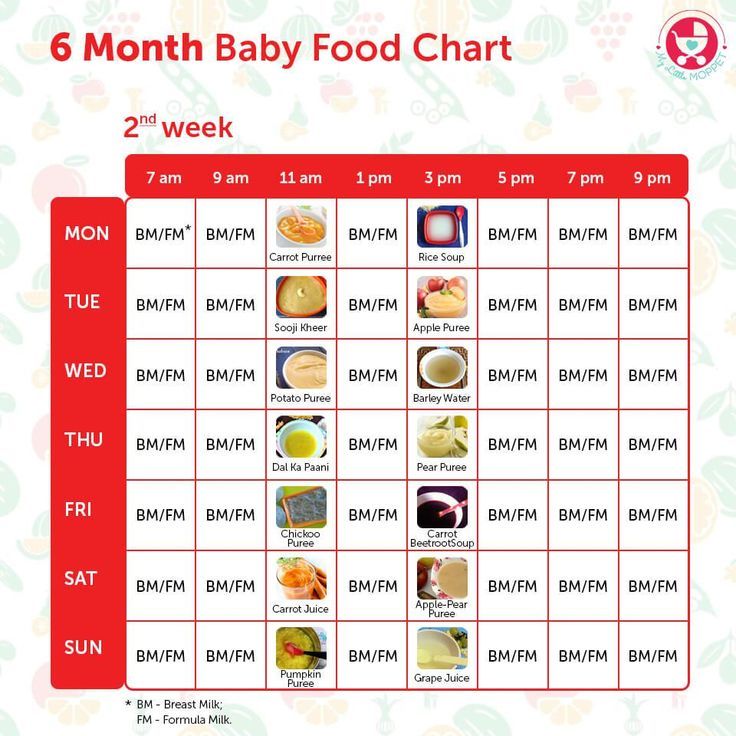 If you haven’t yet, now is a great time, as introducing them earlier on may help prevent an allergy (16, 17, 18).
If you haven’t yet, now is a great time, as introducing them earlier on may help prevent an allergy (16, 17, 18).
It’s a good idea to introduce allergens one at a time and wait a few days in between so that you can monitor your baby for any possible reaction (19).
Signs of an allergic reaction include (20):
- wheezing or coughing
- swelling in the lips or throat
- a runny nose
- itchy skin or a rash
- diarrhea, vomiting, or other signs of stomach upset
If you notice any signs of a mild allergic reaction, such as a rash or upset stomach, call your pediatrician. Call 911 if the symptoms are more severe, such as if you suspect anaphylaxis, which usually involves wheezing, hives, drooling, and drowsiness (21).
Packaged foods
Offering packed foods to your baby can be a convenient way to feed them when you’re short on time. We recommend offering a variety of whole foods whenever possible, but having some packaged items in the pantry can come in handy.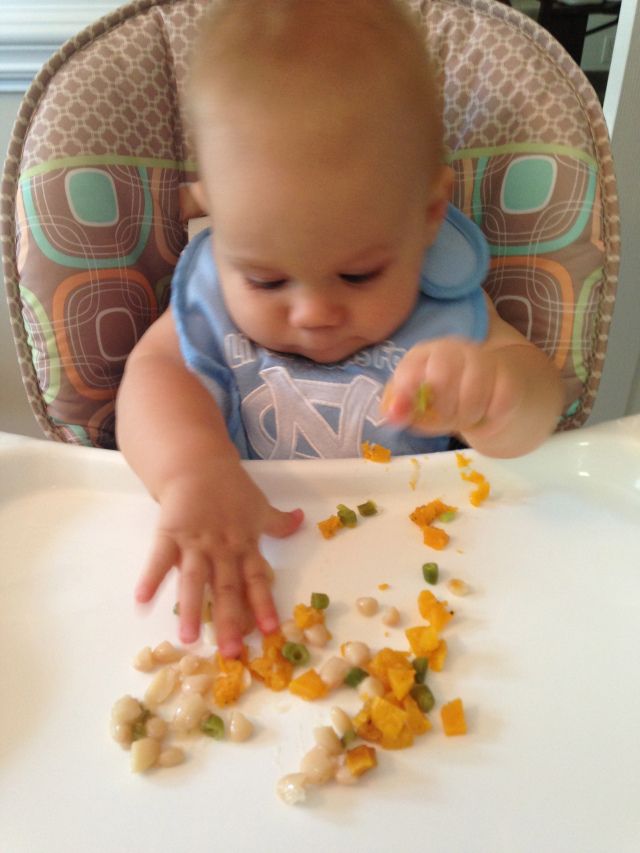
When shopping for packaged baby-friendly foods, look for foods that are low in sodium, added sugars, additives, and preservatives. Additionally, be sure they don’t contain any of the foods that should be avoided in the first year, such as honey.
Lastly, remember that mealtimes should be a fun, low pressure experience. Try not to force your baby to eat more if they are showing signs of feeling full. If they refuse a food, you can try offering it again another time.
Repeated exposure to new foods and maintaining a low stress environment has been shown to promote food acceptance among little ones (22).
SummaryProperly handling, preparing, and storing foods for your baby will help prevent choking and possible foodborne illnesses. Do your best to keep mealtimes fun and relaxed, and let your baby take the lead on how much to eat.
With so many exciting changes and challenges that come with parenting, thinking about and preparing healthy meals and snacks for your 9-month-old baby can feel overwhelming.
By planning ahead and having some go-to meal ideas, you’ll be able to throw together a healthy, balanced plate for your little one in less time.
Preparing some food ahead of time and making your own meal baby-friendly will help save time and the stress of putting together more than one meal.
While 9-month-olds can eat most of the foods you eat, some foods should be avoided, including honey, salt, added sugars, and undercooked or unpasteurized foods.
Properly handling, cooking, and storing your baby’s food will significantly decrease the risk of them experiencing a foodborne illness. Be sure to cut your little one’s food into safe shapes and offer appropriate textures to reduce their choking risk.
Just one thing
Try this today: Combine 1 pound (0.45 kg) of ground meat (chicken, turkey, beef, or pork), 1/2 cup (45 grams) of oat flour, 1 egg, and 2 teaspoons of dried oregano.
Roll the mixture into meatballs and place them on a greased baking sheet in the oven at 400°F (204°C) for 20–25 minutes, or until they’re fully cooked.
Freeze them and defrost 1 or 2 at a time when you need a quick protein source for your little one.
9-Month-Old Baby’s Food: Charts, Menu, and Ideas
Read this article to learn more about the best foods for 9-month-old babies.
What are the best foods for a 9-month-old baby?
It might seem like your baby was a newborn only yesterday, but at 9 months old, they’re developing their own temperament and preferences. Your baby might try the foods that you put on their plate, but they’ll quickly form an opinion and decide which they like and which they don’t.
Most 9-month-old babies are probably partially weaned off breast milk. Many parents choose to continue to nurse their babies once they’ve started to eat solid foods. The process of stopping breastfeeding usually starts when a baby is approximately 6 months old. As they get older, you can introduce new foods to their diet.
From 9 to 12 months old, your baby needs approximately 750–900 calories every day. Between 400 and 500 of those calories should come from breast milk or formula.
Between 400 and 500 of those calories should come from breast milk or formula.
The remaining calories will come from food. Don’t introduce cow milk until your baby is at least a year old. Before that, their digestive systems aren’t prepared to digest cow milk properly.
Take a quiz
Find out what you can do with our Health Assistant
Here are some of the best baby foods for 9-month-olds:
- Non-citrus fruits — Fruits are a great way to provide a sweet snack for your baby without any added sugar. For now, stay away from citrus and stick to fruits like apples, pears, mango, papaya, bananas, and peaches.
- Oatmeal — Oats are packed with fiber and minerals, which can do wonders for your baby’s digestion.
- Bread — As long as your baby doesn’t have any food allergies, you can give them bread. Try to give them whole grain bread, since it’s more nutritious than white bread.
- Vegetables — Your 9-month-old baby can eat vegetables prepared many different ways.
 From pureed carrots or roasted cauliflower to fresh leafy greens, offer your baby different vegetables to see what they like best.
From pureed carrots or roasted cauliflower to fresh leafy greens, offer your baby different vegetables to see what they like best. - Tofu — Tofu is full of protein, healthy fats, iron, and zinc. Lots of babies like it since it has such a mild flavor.
- Egg yolks — Egg whites are potentially allergenic, so most health care providers recommend waiting until your baby is a year old to introduce them. However, at 9 months old, your baby can try egg yolks. Make sure that you cook the yolks thoroughly.
- Lean meats — Even though your baby gets protein and iron from breastmilk or formula, you can start adding other sources of protein into their diet. If your family eats meat, lean red meat, chicken breasts, and fish are great options. Remember to cook any meat thoroughly and cut it into small pieces so that your baby can eat it easily.
- Cheese and yogurt — Your baby shouldn’t have cow milk yet, but they can start eating сheese and yogurt.
 These are great foods for 9-month-olds, since they’re full of calcium, and most babies love them. Stick to soft, pasteurized cheeses such as cottage cheese and natural yogurt without artificial flavorings.
These are great foods for 9-month-olds, since they’re full of calcium, and most babies love them. Stick to soft, pasteurized cheeses such as cottage cheese and natural yogurt without artificial flavorings. - Nut butters — Health care providers used to advise avoiding nuts during infancy because they were believed to be allergenic. However, experts now agree that nuts are safe for babies older than 6 months old, as long as they haven’t shown signs of allergies to other foods. Nut butters are packed with protein, healthy fats, vitamins, and minerals.
- Beans — Beans and lentils provide lots of protein, iron, and minerals. You can puree them or mix them with rice to create a balanced meal for your baby.
Love Flo and highly recommend it to everyone! I'm pregnant because Flo helped me track my period and ovulation.
9-month-old baby’s food menu
When offering 9-month-old babies food (especially finger food), size is important. Pieces should be large enough to pick up, but small enough that your baby won’t choke. Try to aim for cubes about a third of an inch in size. This is just a little bit bigger than a standard pea.
Pieces should be large enough to pick up, but small enough that your baby won’t choke. Try to aim for cubes about a third of an inch in size. This is just a little bit bigger than a standard pea.
Here are some ideas for a healthy, balanced menu for your 9-month-old baby:
Breakfast:
- Cheese sandwich
- Oats with yogurt and fruit
- Egg yolk scramble with bread
Lunch (non-vegetarian options):
- Meat and vegetables
- Creamy chicken soup
- Pasta with meat or chicken
- Beans and rice
Dinner:
- Tofu and vegetables
- Mashed potatoes and cheese
- Macaroni and cheese
Snacks:
- Yogurt parfait
- Peanut butter and fruits
Remember that your baby still needs formula or breast milk. If you’re trying to get your baby used to an eating schedule, store your breastmilk and feed it to your baby when they wake up, right before bed, or between meals.
Quick ideas for 9-month-old babies
- Sandwiches — Sandwiches are easily customizable to your baby’s taste. You can try all kinds of ingredients such as cottage cheese, chicken, avocado, vegetables, peanut butter, and fruits.
- Pasta — Your baby can eat pasta now, so you can try creating one of your favorite pasta dishes for your baby.
- Fruit smoothies — Mix some yogurt with your baby’s favorite fruits and vegetables for a quick, easy, and delicious snack! But make sure the yogurt is low on sugar and artificial sweeteners.
9-month-old baby’s food advice
Try to avoid fried foods, sugary drinks, and processed foods, which should be offered very sparingly due to their low nutritional value. Scientific studies have shown that babies can become accustomed to unhealthy foods like french fries, salty snacks, and sugary sweets from a very young age.
As you introduce your baby to new foods, remember to be patient and provide lots of options.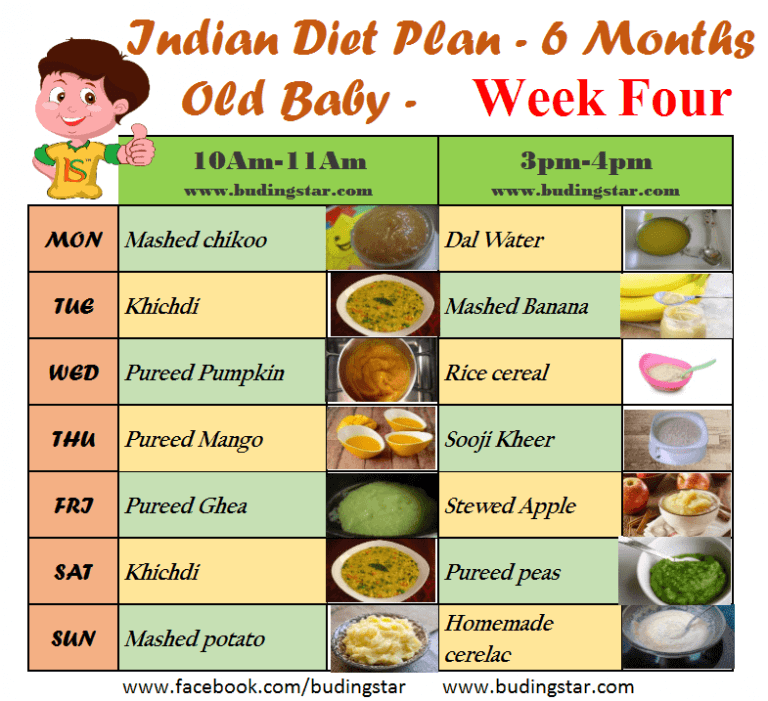 Once your baby discovers there’s a whole world of delicious new foods waiting for them, they’ll love exploring all the flavors and textures that are out there!
Once your baby discovers there’s a whole world of delicious new foods waiting for them, they’ll love exploring all the flavors and textures that are out there!
Baby menu at 9 months
Contents
The need for breast milk and formula is gradually reduced, but not eliminated. The soon-to-be one-year-old toddler still needs enough of the nutrients found in mother's milk or infant formula, so he can breastfeed in the morning and evening, and drink new foods with formula milk. By the ninth month, the main foods for complementary foods have already been introduced, and the child eats quite diversely: cereals, vegetables, fruits, meat, and dairy products are already on his menu. Now it is important to expand the baby's diet with new food, consisting of a variety of dishes.
In order to obtain the substances necessary for the body, the child's diet should be gradually expanded. Gerber® meat purees meet all the needs of the crumbs and well develop his taste perception.
DISCOVER THE PRODUCT
The correct diet for a nine-month-old baby includes 5 meals: a day the baby gets two liquid meals and three thick ones. This is due to the fact that mashed potatoes and cereals take longer to digest than milk, so they give the baby a longer energy supply. Feeding is usually carried out at intervals of 4 hours. If the baby asks to eat 2-3 hours after liquid food, offer her a baby snack, fruit or vegetable (in small pieces or in the form of a puree).
Your 9-month-old baby's daily diet includes many healthy foods and drinks that provide essential nutrients such as vitamins, proteins, carbohydrates, fats and minerals. In addition to milk and infant formula, the following products can be given to a child:
- Fruits and vegetables in the form of puree (apple, pear, cauliflower, etc.)
- Fruit juices and compotes without sugar.
- Meat in various forms.
- Fish.
- Kashi from various cereals.

- Chicken or quail egg yolk.
- Children's fresh cottage cheese.
- Children's low-fat kefir.
- Children's cookies, croutons, bread.
See also: Toddler refuses new foods
According to WHO recommendations, by the 9th month, the menu should already contain all of the above products. If something from the food is still unfamiliar to your child, it is recommended to gradually add it to the diet. You have to start at
minimum servings, watching how the child reacts to the new food. If there is no allergic reaction to the product, you can increase the volume and add it to new dishes. New complementary foods are recommended to be introduced at intervals of 5-7 days. An indicative table for one day will help to create an optimal diet for health. It also shows how much formula or milk the baby should eat per day.
* infant formula.
**Dairy-free porridge should be diluted with breast milk or infant formula given to the baby.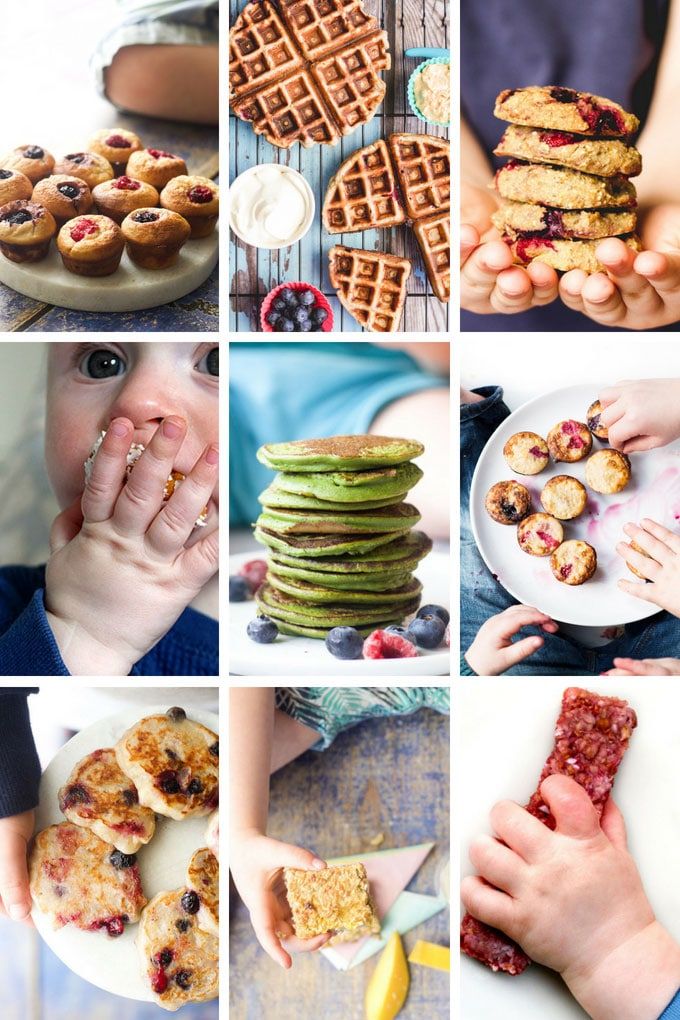 Milk porridge is diluted with water.
Milk porridge is diluted with water.
I feeding
6 hours
Breast milk or a medical mixture for children with cow milk proteins
200 ml
II feeding
10 hours
Silent porridge*
Fruit pure )
180 g
approx. 1 tsp
70 g
III feeding
14 hours
Vegetable puree or pureed soup
Vegetable oil
Vegetable oil
turkey meat 90.60005Fruit juice
180 g
approx. 1 tsp.
9000 6 g70 g
IV feeding
18 hours
Fruit puree
Vegetable puree or silent porridge
Pure Puree
9000 180 gabout 1 tsp.
50 g
V feeding
22 hours
Breast milk or medicated formula for infants with cow's milk protein intolerance
200 ml
*Dairy-free porridge should be diluted with breast milk or formula for infants with intolerance to cow's milk proteins.
**you can either alternate between porridge and vegetables or offer a mixed dish - porridge with vegetables.
1st day
First breakfast
Breast milk or formula milk
Second breakfast
Buckwheat porridge with pumpkin, juice
Lunch0006 Half
crackers or children's cookies, yogurt
dinner
puree of cauliflower
second dinner
breast milk or milk mixture
2. Second day
breast milk or milk mixture
second breakfast
Oatmeal, berry juice
Lunch
Steamed fish, rice, fruit compote
Snack
Vegetable puree
Dinner
Vegetable puree
Second dinner
Breast milk or milk mixture
3. Third day
First breakfast
Breast milk or milk mixture
Second breakfast
Sunny, quail egg yolk
zucchini for steam veal, apple compote
Afternoon snack
Pumpkin and apple puree
Dinner
Cottage cheese casserole with carrots
Second dinner
Breast milk or milk formula
4.
 Fourth day
Fourth day The first breakfast
Breast milk or milk mixture
Second breakfast
rice porridge, fruit puree
Potato puree or turfs from turkey
carrot-Yablanny juice
Second dinner
Breast milk or formula
5. Day five
First breakfast
Breast milk or formula
Second breakfast
Oatmeal porridge and puree from apples
Lunch
Puree soup and vegetables
SUPPORT
CAROCOL COOK
puree of cauliflower, crackers or bread
second dinner
Breast milk or milk milk formula
6. Sixth day
First breakfast
Breast milk or formula
Second breakfast
Rice porridge, half yolk (chicken egg
Lunch
Vegetable soup with chicken breast, juice
Snack
Baked apple
Dinner
PEACH PEACHER with spinach
Dinner
Milk or milk mixture
7.
 Seventh day
Seventh day BOST BOTTED
BRONEM milk formula
Second breakfast
Millet porridge, croutons
Lunch
Steamed chicken cutlets, vegetable puree
Afternoon snack
Apple juice
Dinner
Cottage cheese with fruit
Second dinner
Breast milk or formula
chew food. If this is not done in a timely manner, a baby may refuse solid food in a year. Changing the consistency of dishes favorably affects the development of the digestive system.
No need to grind fish and potatoes in a blender - just put the food on a plate and mash well with a fork. Meat can be offered in the form of meatballs to develop chewing skills. It can be turkey, rabbit, veal, beef, chicken. The norm of meat for one meal is 60-70 g.
It is quite normal if at first large pieces in the dish cause discontent or even a gag reflex in the child - he will soon get used to it. Sometimes it happens the other way around - the baby willingly tries the pieces, but refuses pureed food. Treat your baby with apple slices, bread, crackers or baby snacks. But the meat is still better to grind thoroughly.
Treat your baby with apple slices, bread, crackers or baby snacks. But the meat is still better to grind thoroughly.
At this age, consumption of mother's milk or adapted formula decreases. There are only two feedings per day - in the morning and in the evening. Everything else is "adult" food. Ideally, the baby should sleep through the night and get up at 06:00-07:00. If the little one wakes up at night, it is already possible to gradually wean him from feeding at night (provided that he is gaining weight normally). You can consult with your pediatrician about this.
Please note that uneaten food (already cooked) must not be stored and reheated. It is also not recommended to add sugar and salt to the dish.
If you give your child ready-made baby puree, we recommend that you do not feed him immediately from a jar, but pour the right amount onto a plate. In this case, the rest can be stored in the refrigerator for another 24 hours.
Find out more: Baby Portion
Pay attention to the quality of the food you cook: appearance, smell and expiration date.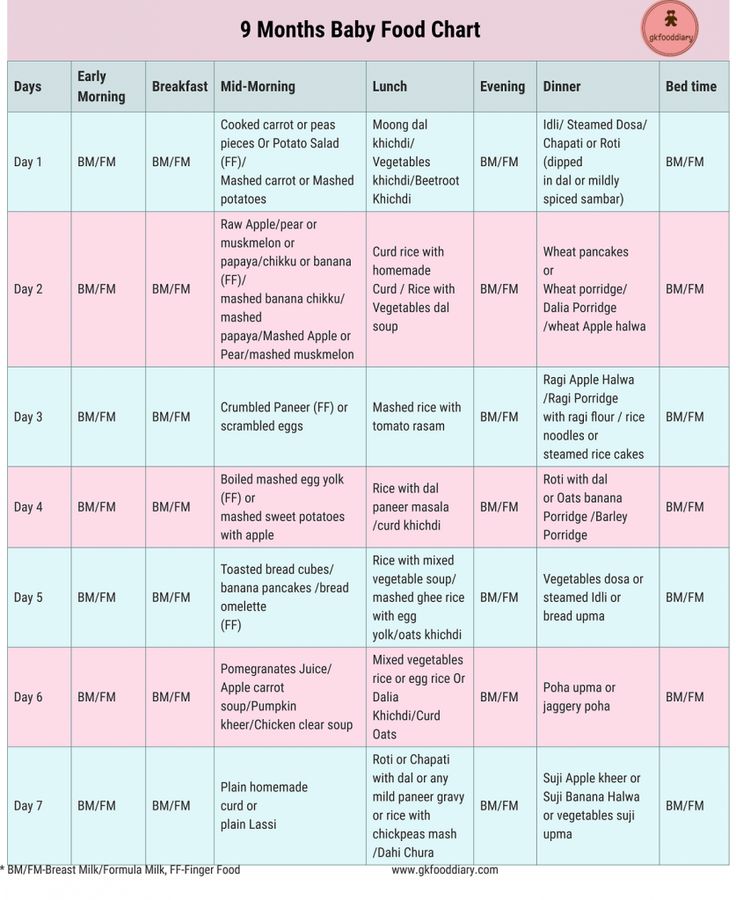 It is better to use seasonal vegetables and fruits, and shop in trusted places.
It is better to use seasonal vegetables and fruits, and shop in trusted places.
Wash food thoroughly under running water before cooking. You can also use special children's products for washing fruits and vegetables.
All products must be brought to full readiness, and then thoroughly crushed to the desired consistency, so that the baby can comfortably chew small pieces. After eating, wash the dishes with a special detergent.
How to properly feed a 9-month-old baby who refuses food and does not eat the foods you suggest?
Poor appetite is one of the indicators of a baby's health. The problem may concern the digestive tract, glucose levels, central nervous system. The feeling of hunger appears when the level of sugar in the blood decreases. But for this you need to take breaks between meals. Also, the smell of food affects the appetite - it causes the release of gastric juice.
How to restore your appetite:
- observe the diet;
- develop a delicious menu for a 9 month old baby;
- Serve dishes beautifully and set the table;
- ventilate the room before eating;
- let the baby use cutlery.

Read also: The baby does not eat well, how to feed?
In order for the baby to eat willingly, he must be in an excellent mood. Try to avoid stressful and nervous situations, feed him in a calm, comfortable atmosphere.
If the baby refuses to eat or eats very slowly, do not rush or force him to eat. Also, do not force the little one to eat foods that he refuses. Otherwise, in the future, he will have a negative attitude towards the feeding process, refuse to eat any food at all. He can even feel sick and vomit only with one kind of food.
Important Games and cartoons during meals do not actually improve appetite. On the contrary, in this way you only teach the baby to eat without noticing the dishes.
With the help of our tips, you can create a menu for a child at 9 months for every day, which will meet the requirements of a healthy diet and preferences of the baby
1. What should not be given to a child at 9 months?
It is not recommended to give cow's milk until the age of one. It contains too much calcium, which overloads the kidneys, and protein, which is poorly digested. Also be careful with foods that can cause allergies or contain a lot of sugar
It contains too much calcium, which overloads the kidneys, and protein, which is poorly digested. Also be careful with foods that can cause allergies or contain a lot of sugar
2. Should oil be included in a baby's diet?
A 9-month-old baby's menu should include animal and vegetable oil, as it contains many vitamins, proteins and fatty acids necessary for the proper development of the baby. Among the useful products of plant origin, it is worth noting olive, corn, sesame or linseed oil.
3. Can a 9-month-old baby be given fish?
Low-fat white fish can be a healthy addition to your baby's menu. It is recommended to give fish 1-2 times a week instead of a meat dinner - flounder, cod, hake or pike perch are suitable. If the baby responds well to the product, try making fish cakes or meatballs.
Articles on the topic:
Diet for a child aged 9-12 months
By 9 months the main complementary foods have already been introduced, so the expansion of the child's diet continues. It is important to know that at this age the consistency of the products should change from homogenized to finely and coarsely ground.
It is important to know that at this age the consistency of the products should change from homogenized to finely and coarsely ground.
A meat dish for an older child can be offered in the form of meatballs, which diversifies the child's diet and stimulates the formation of chewing skills. Canned meat industrial production for children over 8 months. - coarsely chopped, spices and spices (white pepper, celery, parsley, dill, onion, basil, thyme) can be added to them.
The volume of fish puree increases to 60 g per day by 12 months. Fish is given 2 times a week boiled without broth (instead of meat).
At this age, children's pasta can be offered to the child.
The number of children's cookies and crackers is increased up to 10-15 g per day (2-3 cookies).
By the year it is useful to add finely chopped fresh garden greens (dill, parsley) to various dishes, which significantly enriches the diet with vitamins and minerals.
Sample diet for a 12 month old child:
| breakfast 8 hours | Dairy-free or milk porridge* Butter Boiled egg yolk Fruit puree | 150-200 g approx. 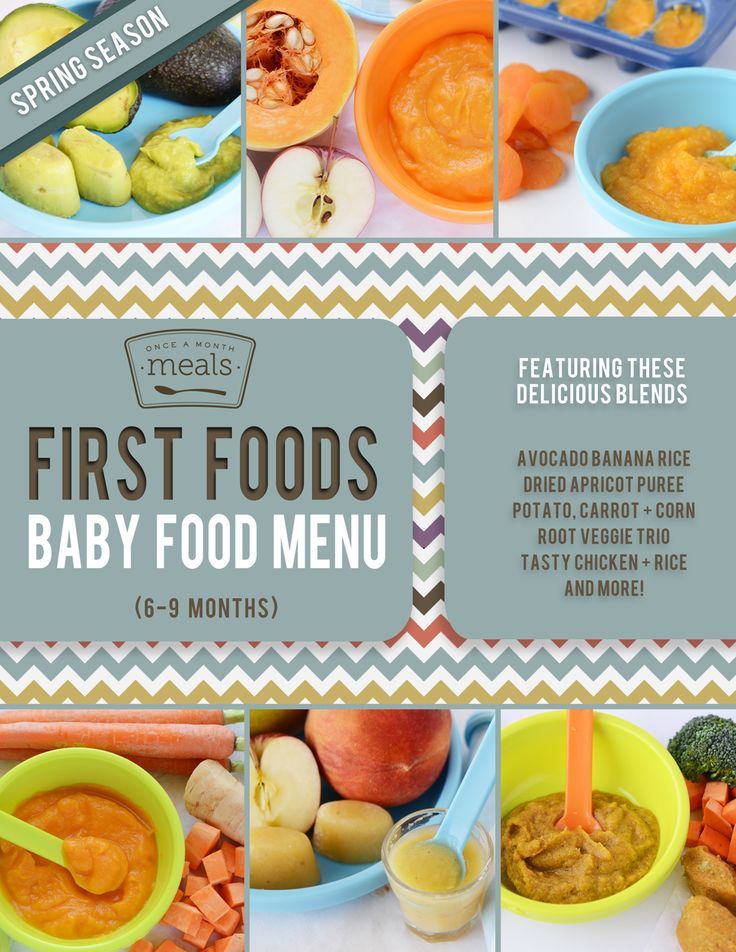 1 tsp. 1 tsp. 1/2 pcs 50 g |
| lunch 12 noon | Vegetable puree Vegetable oil Meat puree (meatballs) or fish Bread/rust Compote | 180 g |
| afternoon tea 4 pm | Breast milk (kefir or yoghurt)** Cottage cheese Fruit puree Baby biscuits | 100 g 50 g 50-70 g 2 pcs |
| dinner 20 hours | Vegetables or porridge** Meat puree Vegetable oil Fruit juice | 180 g 20 g 1/2 tsp. 50 ml |
| before bedtime 11 pm | Breast milk (DMS)*** | 200 ml |
* - dairy-free porridge should be diluted with breast milk or infant formula that the child receives. Milk porridge is diluted with water.
Milk porridge is diluted with water.
** - the daily volume of kefir or yogurt can be up to 200 ml,
*** - baby milk formula
Approximate diet of a 12-month-old child with an allergy to cow's milk proteins:
| breakfast 8 hours | Dairy-free porridge* Vegetable oil Fruit puree | 150-200 g approx. 1 tsp. 50 g |
| lunch 12 noon | Vegetable puree Vegetable oil Meat puree/meatball Bread/rust Compote | 180 g about 1/2 tsp. 50-70 g 10 g 50 ml |
| afternoon tea 4 pm | Breast milk or medicated formula for infants with cow's milk protein intolerance Fruit puree Rusk | 150-180 ml |
| dinner 20 hours | Vegetables or dairy-free porridge** Vegetable oil Meat puree Fruit juice | 180 g about 1/2 tsp. 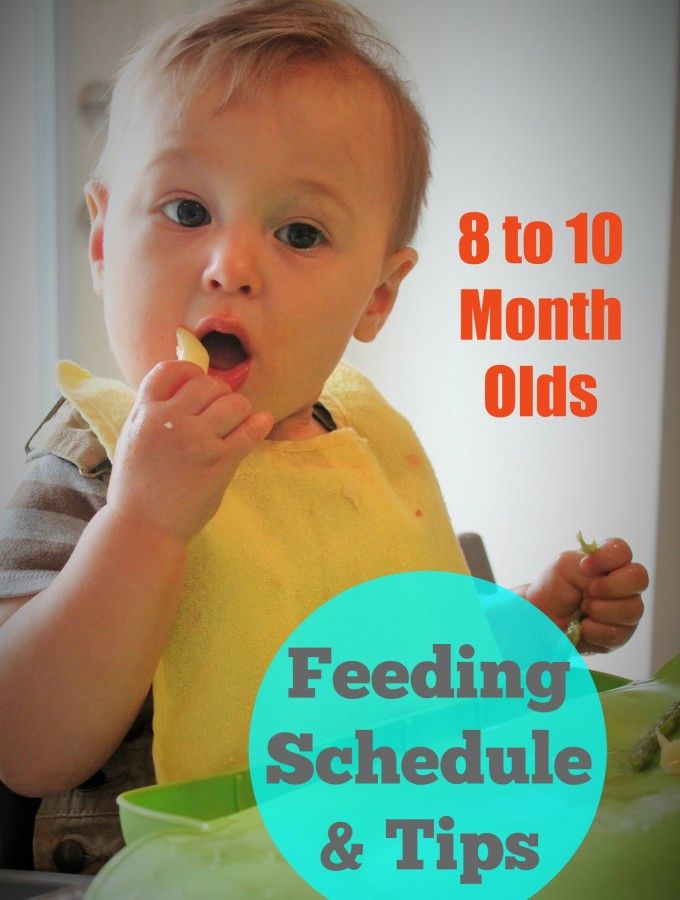 |


